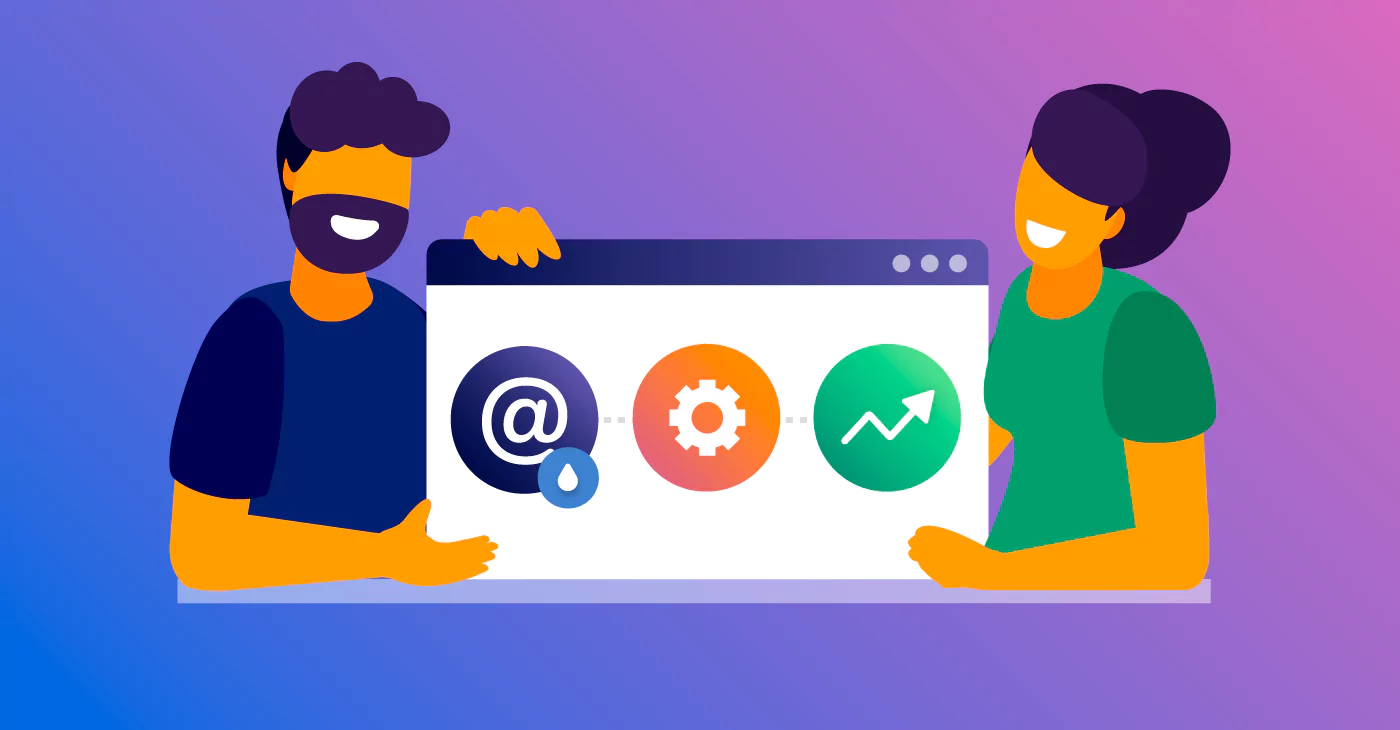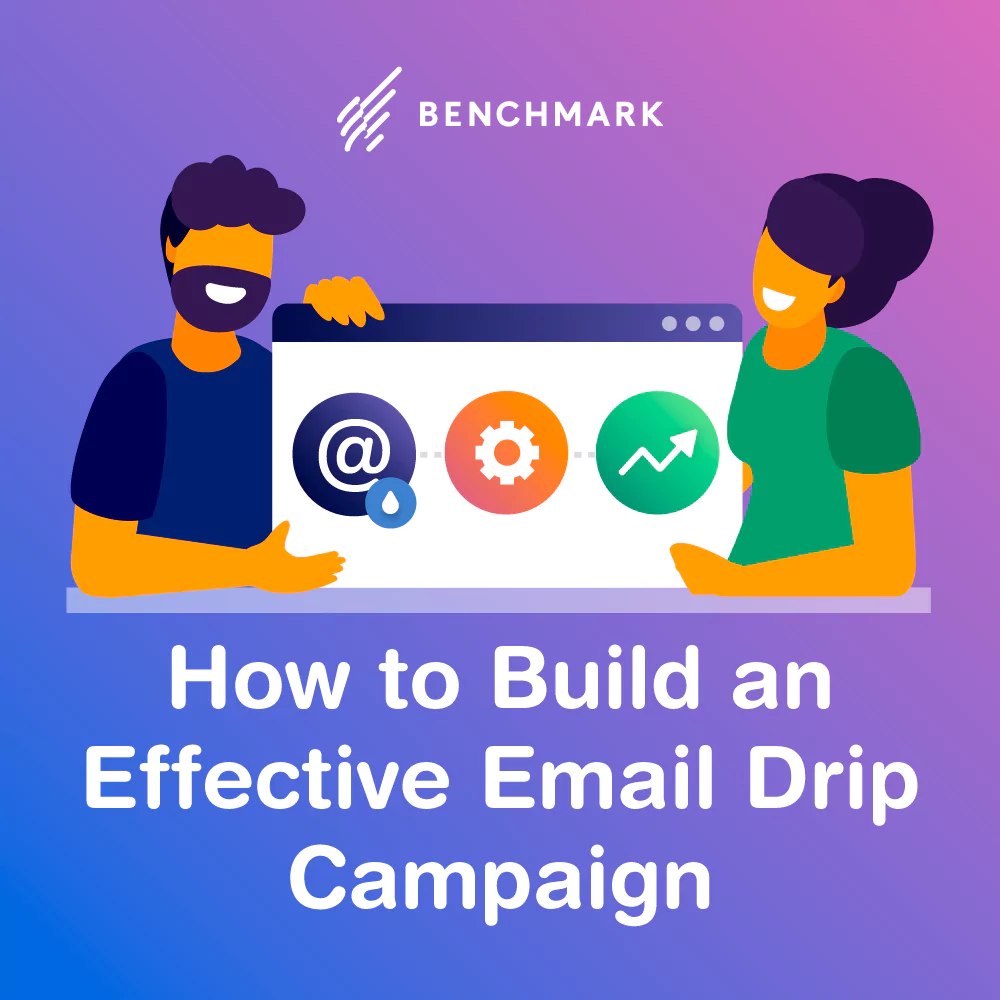Email Marketing Benchmark Recommends
How to Build an Effective Email Drip Campaign
July 13, 2023 8 min read

Drip campaigns are one of the types of emails you should be sending and are crucial in educating, nurturing, and converting your prospects. They’re the star player in your overall marketing and sales game, so assembling them must be done with a lot of thought, care, and strategy. You also need a firm grasp on what makes your prospects tick so you can fill your campaigns with targeted content and the right message, which will move them through the funnel more seamlessly.
Drip campaigns have this annoying habit of seeming like a very confusing strategy, one with a lot of moving parts and factors that ultimately determine their success. While it’s true that a lot goes into them, they’re actually a huge time-saver, and putting them together doesn’t have to be such a headache.
We’ll cover all of the basics that you need to know about drip campaigns, including the benefits that they offer your marketing strategy and how to put them together effectively. So don’t grab the Excedrin just yet.

What is a Drip Campaign?
A drip campaign is a form of marketing automation where you send customers and prospects a series of emails ‘drips’ at specified time intervals based on their actions and changes in status during the sales cycle.
Since it’s automated, you don’t have to lift a finger to send out individual emails. Instead, you can pre-program the triggers, conditions, and actions that the email marketing software should use to decide when to send which email.
Triggers are the predetermined events that set the drip campaign in motion. Some of the common drip campaign triggers include:
- A customer abandoning the shopping cart
- A prospect leaving your website without taking any action, e.g., subscribing or purchasing
- A customer subscribing to your newsletter
- A prospect creating an account in your online store
Besides that, drip campaigns use conditions to commence an engagement action. A condition is a pre-configured rule that determines when to send out an email. A condition is something like:
- Sending a confirmation email when a customer completes a purchase.
- Sending a welcome email once a customer subscribes to a newsletter
- Waiting for a specific number of days before sending a cart abandonment email
Actions refer to the actual engagement components that create the connection between your brand and customers. Emails are the typical actions in a drip marketing campaign (which makes sense because email has an ROI of 3600%E1EW32).
However, depending on your drip marketing strategy, you can include other actions such as SMS messages, push notifications, or social media direct messages.
Why is a Drip Campaign Useful?
A drip campaign automates email cadences and workflows to provide prospects with as much information as possible to make a buying decision. It enables you to build and deepen trust with customers because you can send personalized emails. Doing so helps capture leads and nurture them into buyers.
Drip campaigns are automated, meaning the actions take place on autopilot. You configure the email automation software and leave it to push leads toward conversion without a hassle. This saves you a fair amount of time that you can instead spend on other vital activities.
Moreover, it reduces the acquisition cost per customer. The email series is automated and triggered by user behavior: prospects move along the lead pipeline without the need for manual or 1-on-1 selling. As a result, you reduce the workload and get more qualified leads (brands that use drip marketing see a 451% increase in qualified leads).
What’s more, drip campaigns can reduce prospect irritation. Without a drip campaign, you’d have to cold call or email your prospects. Bombarding prospects with ill-timed salesy emails may not sit well with a section of your prospects; they might mark you as spam. With drip campaigns, you can gently nurture the relationship whilst they are considering your brand proposition and moving towards a buying decision.
The Benefits of an Email Drip Campaign
When it comes to marketing, every minute matters, and every strategy has to deliver. So let’s get into the weeds a bit on the beneficial reasons to invest time and resources into drip campaigns.
1. Personalized Content
Personalized emails result in transaction rates that are 6x higher than non-personalized emails. The whole point of drip campaigns is to offer your audience a consistent stream of touchpoints, filled with personalized content based on what they need and where they are in the buyer’s journey. Each email within a drip campaign works off of each other, offering a little bit of content each time that is meant to help solve a problem your prospect is having.
2. Steady Progress
Drip campaigns aren’t designed to push leads through the funnel faster than usual. Instead, they guide them at an even pace, gradually helping them become more informed and moving them closer to a decision. As I mentioned in the previous point, each email is meant to work off the one sent prior. They’re designed to assist you with creating a steady progression for your prospects, informing them more and more with each email, hence moving them through the funnel at a controlled pace they’re comfortable with.
3. Smarter Leads
An educated prospect is a better prospect. With drip campaigns, you’re providing ongoing education for your leads, proving your worth, and building trust. The result is a well-informed lead, and we all know that a knowledgable lead makes for a strong, long-lasting customer relationship.
Okay, now it’s time to get started. Enter: email automation software, of course. When paired with an effective CRM, the right automation platform can help you track and analyze your prospects to figure out where they are in the buyer’s journey and segment your lists for your drip campaign. It will also allow you to put together the drip campaign and automate it for marketing ease.
When Should You Use a Drip Campaign?
Some of the instances to use a drip campaign include:
1. Nurturing Cold Leads
A drip campaign is akin to an always-present assistant for your lead conversion program. It ensures prospects get the right information at the opportune time and phase in their buying cycle. Capturing and nurturing leads is the primary use of drip campaigns.
For example, if you sell software and a prospect downloads some of your content, you can send a series of emails with additional tips, the features they need, and current product promotions available.
2. Onboarding Customers
In addition, you can use a drip campaign to streamline initial customer success. Let’s say you have an inventory management app. When new users sign up, you can walk them all the way through until they can use the app on their own.
This could mean sending them an email series to show them how to set up their accounts, know your product’s capabilities, and get value from each feature. The series may include FAQs, tutorials, and how-to guides triggered when a predetermined milestone is reached.
3. Upselling and Cross-Selling
You can also extend your drip campaign beyond conversion. For example, when a customer buys a pair of shoes, you can send them a thank you email and include promotions for the shoe care kits that work well with the shoe they purchased.
How to Build an Email Drip Campaign
Putting together a drip campaign is a lot easier than you might think, once you have the right tools. Follow the steps below and create a campaign driven to convert.
Step One: Tier Your Prospects
To make sure the right content is sent to the right people, you need to segment your prospects based on where they are in their journey. Here’s a quick breakdown of what that might look like.
- Leads — Awareness phase. Leads are anyone who visits your site. Their level of knowledge regarding what you do is most likely low.
- Prospects — Awareness and consideration phase. Prospects are anyone who downloads something on your site and subscribes to your email marketing campaign. They may know a little bit more about what you do, but they’re still learning more about you. This is where your email drip campaigns come in to play.
- Opportunity — Consideration phase. When a prospect becomes an opportunity, it’s because they’ve asked for a demo of your service or product. They are now seriously considering working with your company.
- Customer — Decision phase. Customers are obviously anyone who decides to partner with you and use your service or product. You’ve done it! You converted a lead to a customer!
- Closed/Lost — Anyone who qualifies as an opportunity but then decides against moving forward, for whatever reason. Womp, womp.
- MIA — Unresponsive opportunities who go dormant after requesting a demo. Super womp, womp.
There’s an opportunity within each of these classifications to engage (and re-engage) in a way that moves the relationship forward. To do it, move on to step two.
Step Two: Create Content for Each Stage
Collaborate with your sales team and your account team to gather insights on the pain points of people in each of the classifications mentioned in step one. What do they want to know? What don’t they know already but should? What might they be confused about at this stage?
Once you’ve workshopped a bit and built audience personas for each group, get to work creating content that addresses their unique wants and needs, or start assembling your existing content that fits within these areas. Think broadly, focusing on general content that can be useful for each type of lead/prospect, including gated resources, manuals, webinars, and blog posts. Having this content on hand will give you a good base of educational materials that you can then put to use in your drip campaigns.
Step Three: Segment Your Lists
You’ve tiered your prospects already, so now it’s time to create your actual email lists. Create a list for each tier, and make sure to automatically enroll new prospects into the most appropriate list for their current stage.
How you do this depends on how your marketing automation software helps you qualify your prospects. Some allow you to take into consideration a lot of factors, like actions they’ve taken on your site, the industry they’re in, and the size of their company. But at the end of the day, you should have segmented contact lists that you can easily connect throughout each campaign.
Step Four: Craft Your Emails
Once you’ve got your lists segmented, start putting together the actual email series for your drip campaigns. To make it easy on yourself and your team, you may want to tackle just one prospect tier at once. Start small while you get your footing and see what works, and then adjust accordingly.
Make sure you create engaging email content that will delight your prospects. You want them to enjoy reading your emails and look forward to opening them. Don’t forget to add links to your existing content so that you can make these more personalized and helpful.
Step Five: Check In to Measure Success
Let your drip campaigns run their course for a few months, then check to see how well they’re performing. Focus on how well they’re able to move prospects through the funnel and see if your sales team is getting any feedback for improvement. Also, look at click-through-rates, open rates, and conversion rates to help determine overall success. Sometimes, something a simple as swapping in updated and/or otherwise enhanced content will be enough to overcome hurdles.
Remember: drip campaigns are ongoing strategies. Tweak your practices and your content as needed, and always use any associated data to help evolve your campaigns. Soon, you’ll have a drip campaign that operates — and excels.



